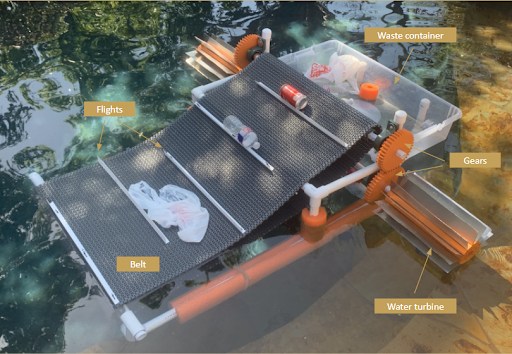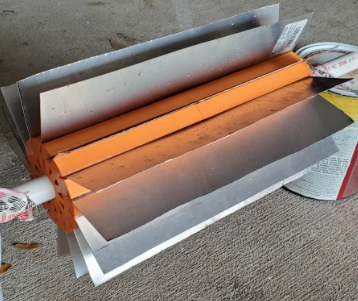Semester 2 - Blog Post #4
- nofilhaque98
- Apr 16, 2021
- 3 min read
Over the work period of March 26th through April 16th, we have finished the prototype, begun preliminary validation results, and presented our final presentation slides. A picture of our prototype is shown below in the figure to the left. The gears, water turbine centers, and cuff stabilizers for the axle-to-bearing connections have been 3D printed. The water turbine’s aluminum sheet blades have been constructed. A close up of the completed turbine is shown below to the right. The PVC pipe structure has been sealed off with PVC cement and water tight putty to increase the device’s buoyancy. Flights have been attached perpendicular to the belt every 9.5 inches to aid in guiding debris up the belt toward the waste container.
After completing our prototype, we began preliminary validation tests to see how our device met the benchmarks we set last semester. Our first and most important requirement was that the device collected at least 90% of debris that was directly in front of it. For our tests, we used a total of 5 pieces of debris: a water bottle, can, plastic bag, wrapper, and yogurt tub. All but the yogurt tub was successfully collected. The tub was slightly too big for the 1.25 inch flights to easily pick up. This means that for our preliminary testing, 80% of the intentionally placed trash was collected. Secondly, our device met the size requirement of being less than the dimensions of a standard pedal boat. We chose this size to limit the impact the device could have on the functionality of the watercraft. We decided that the storage container should be able to hold a minimum of 20 standard water bottles. Our selected container holds up to 64 water bottles which greatly exceeds this benchmark. The final validation check was on how easily the waste can be removed since it is meant to be taken care of regularly by the user. For this, we used the ratings of 5 unbiased persons who were not familiar with our device. The average rating among them was an 8.8/10 which our team is satisfied with.
The results mentioned before match the goal of skimming pollutants off the surface of small bodies of water without the need of a complex diesel engine or a trained operator.
The team has yet to complete the final validation. This will be done in the next two days. For the preliminary test, only 5 pollutants were placed to be picked up. For the final validation, 5 tests will be conducted with 4 pollutants each time which will result in a total of 20 pollutants. Since we want the device to pick up 90% or more of the trash, 18/20 of the debris must be collected to reach this benchmark. Although the belt does rotate when the device is moved at 3ft/s, a lighter belt would lower the amount of drag force experienced by the device. If we had a larger budget, we would’ve bought a lighter belt with a more open flush grid. This would have allowed more water to pass through the belt and lower the stress on the gears and turbines. Two possibilities to improve the design are to purchase longer flights, given that it does not increase the drag produced, and to cap the ends of the water turbines to see if torque is affected.







Comments